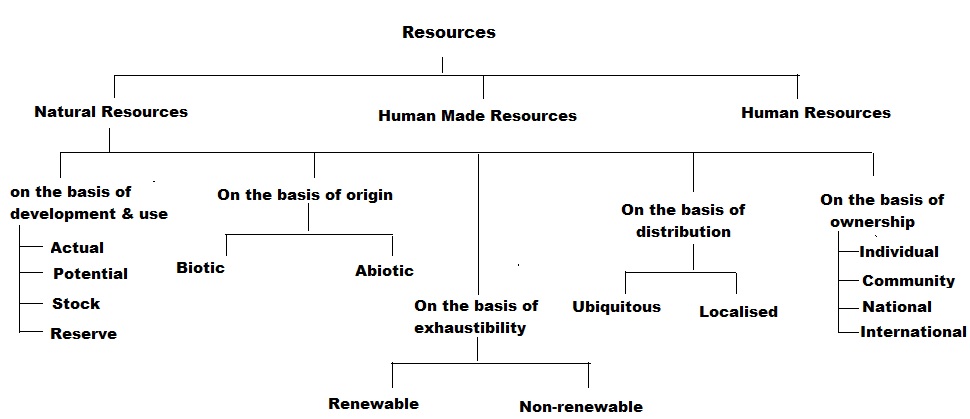Concepts
Anything which can be used to satisfy a need is a resource. Some resources have economic value, while some do not. For example, milk has economic value, but a beautiful landscape has no economic value. But both are important because both satisfy some human needs. Time and technology are two important factors which can change a substance into resources. For example, petroleum was not a resource before people learnt to use it.

- Resource : Anything that is useful or has value. A value can be of various kinds:
- Legal Value: Attached to the quality of resources.
- Economical Value: Used for production
- Aesthetic Value: Attached to the natural scenic beauty
- Ethical Value: Associated with the moral value, human conduct and behaviour.
- Resources are distributed unequally over the 'earth because of the different natural conditions, and physical factors like terrain, climate and altitude.
- Types of Resources: Resources are usually classified into three types, viz. natural, human made and human resources.
- Natural Resource: Resources which are obtained from nature are called natural resources. Some of the natural resources can be used directly, while for using some others we need the help of some technologies.
- Types of Natural Resources: Natural resources can be classified on the basis of their level of development and use, origin, stock and distribution.
- Classification of natural resources on the basis of development and use:
- Actual Resource: Resources whose quantity is known and which are being used at present are called actual resources, e.g. coal and petroleum.
- Potential Resource: Resources whose entire quantity may not be known and which are not being used at present are called potential resources. Potential resources can be used in future once technology for that is properly developed. For example, uranium reserves in Ladakh.
- Resource development is the method of utilising our intelligence in order to improve the quality, usability and utility of a resource.
- Classification of natural resources on the basis of origin:
- Abiotic Resource: Resources which come from non-living sources are called abiotic resources, e.g. soil, rocks and minerals.
- Biotic Resource: Resources which come from living beings are called biotic resource, e.g. milk, leather, timber, etc.
- Classification of natural resources on the basis of their exhaustibility:
-
Renewable Resource: Resources which can be quickly replenished are called renewable resources, e.g. wind energy, hydel energy, solar energy, etc.
-
Non-renewable Resource: Resources which cannot be replenished in the near future are called non-renewable resources, e.g. coal and petroleum. It takes millions of years for the formation of coal and petroleum and hence they cannot be replenished in our lifetime.
-
-
Classification of natural resources on the basis of distribution:
-
Ubiquitous Resource: Resources which are available everywhere on the earth are called ubiquitous resources, e.g. air and water. It is not governed by physical conditions.
-
Localised Resource: Resources which are available at select locations on the earth are called localized resources, e.g. coal mines in Jharkhand. Topography, climate and altitude are the major factors which affect the distribution of natural resources. It is governed by physical conditions. Other examples: Minerals.
-
Human Made Resources: When a natural resource undergoes drastic change by human intervention, it becomes human-made resource. For example, iron ore is processed to make steel and hence steel is a man-made resource. Buildings, bridges, railways, machines, etc. are examples of human-made resources. Technology is also a human-made resource.
-
Human Resources : People are the human resources. Education and health improve the quality of human resources. Improving the quality of people's skills to enable them to create more resources is called human resource development.
- Human resources are important because the development of other resources solely depends upon this resource as humans have knowledge, skill, and technology to develop other resources.
-
CONSERVING RESOURCES : Most of the natural resources are limited in stock. Even some of the renewable resources can become scarce if they are not used judiciously. We are already facing shortage of water at many places because of excessive exploitation of water. Scientists predict that coal and petroleum are going to be exhausted in the near future. Hence, it is important to conserve the natural resources. Conservation not only secures our life but also the life of future generations. Making a balance between our need and conservation of resources is called sustainable development. We should follow the three Rs. of conservation for sustainable development.
- Reduce: We should reduce consumption.
- Reuse: We should reuse as many items as possible.
- Recycle: We should recycle discarded items wherever possible.
-

